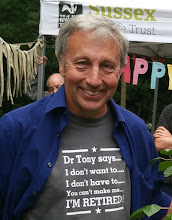
Last night I was delighted to go along to a local group meeting, excellently chaired by Shipley Parish Council, to hear objections to a large landfill site being proposed between Thakeham, Coolham and Ashington. Evening meetings may not be everyone’s cup of tea but it is always an education and I am always impressed with the quality of the case that local people can put together when they are worried about something.
And the proposed landfill at Laybrook is a major worry. Over 4 million tons of rubbish over 21 years, many thousands of lorry movements per year, destroyed tranquillity, impact on local wildlife including the threat of damage to one of the most innovative wildlife projects in the country. http://www.knepp.co.uk/
The developers, however, have “Thakeham Village Action” to contend with and the case being put together is not just a NIMBY reaction, but an excellent articulation of how we should not even be thinking about landfill in the 21st century. We are running out of holes in the ground anyway and this should stimulate us to find much more appropriate solutions to our waste problems. There are many alternative approaches out there and practically every other European country is doing far better than us. Why is it that German people only send 3kg of waste per person to landfill, whereas we send 320Kg?
Throwing things away is an unacceptable side of our consumer society – there is no “away” left and every time we put something in the rubbish bin we should think where it will go. We can’t complain about rubbish dumps at the end of our gardens if we fill up a wheelie bin every week. The only long-term solution is a zero-waste society – create less waste, recycle much more, and even the waste that remains should be a resource for something else.
We now have just a week to object to this proposal, and I would recommend that everyone who chances upon this posting should put in an objection. The details are on the “no Laybrook landfill” web site. http://www.nolaybrooklandfill.co.uk/
Also, of course, these holes in the ground are not devoid of wildlife. One of my previous blog postings includes some excellent information from Pip Edgecombe showing just how valuable this particular area is. These sites are assets and we should be able to come up with far better ideas of what to do with them than fill them with rubbish. The company at the Laybrook site has been making profit out of brick making from clay won from that site for a very long time. And good luck to them. But rather than trying to make yet more money by turning it into a waste dump, surely the more responsible thing to do would be to turn it over to the local community, maybe developing it as a local nature reserve so it can add to the value of the Knepp Wildland project next door rather than threaten it.
And the proposed landfill at Laybrook is a major worry. Over 4 million tons of rubbish over 21 years, many thousands of lorry movements per year, destroyed tranquillity, impact on local wildlife including the threat of damage to one of the most innovative wildlife projects in the country. http://www.knepp.co.uk/
The developers, however, have “Thakeham Village Action” to contend with and the case being put together is not just a NIMBY reaction, but an excellent articulation of how we should not even be thinking about landfill in the 21st century. We are running out of holes in the ground anyway and this should stimulate us to find much more appropriate solutions to our waste problems. There are many alternative approaches out there and practically every other European country is doing far better than us. Why is it that German people only send 3kg of waste per person to landfill, whereas we send 320Kg?
Throwing things away is an unacceptable side of our consumer society – there is no “away” left and every time we put something in the rubbish bin we should think where it will go. We can’t complain about rubbish dumps at the end of our gardens if we fill up a wheelie bin every week. The only long-term solution is a zero-waste society – create less waste, recycle much more, and even the waste that remains should be a resource for something else.
We now have just a week to object to this proposal, and I would recommend that everyone who chances upon this posting should put in an objection. The details are on the “no Laybrook landfill” web site. http://www.nolaybrooklandfill.co.uk/
Also, of course, these holes in the ground are not devoid of wildlife. One of my previous blog postings includes some excellent information from Pip Edgecombe showing just how valuable this particular area is. These sites are assets and we should be able to come up with far better ideas of what to do with them than fill them with rubbish. The company at the Laybrook site has been making profit out of brick making from clay won from that site for a very long time. And good luck to them. But rather than trying to make yet more money by turning it into a waste dump, surely the more responsible thing to do would be to turn it over to the local community, maybe developing it as a local nature reserve so it can add to the value of the Knepp Wildland project next door rather than threaten it.

No comments:
Post a Comment